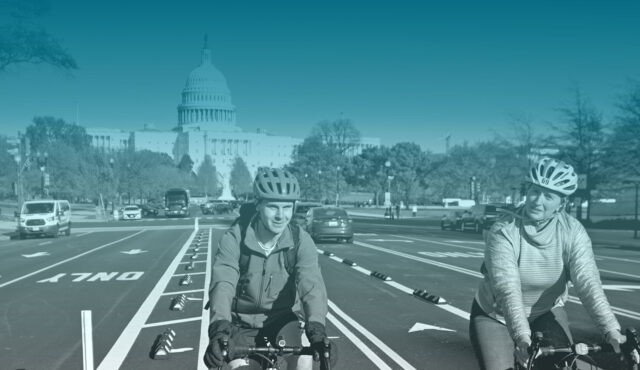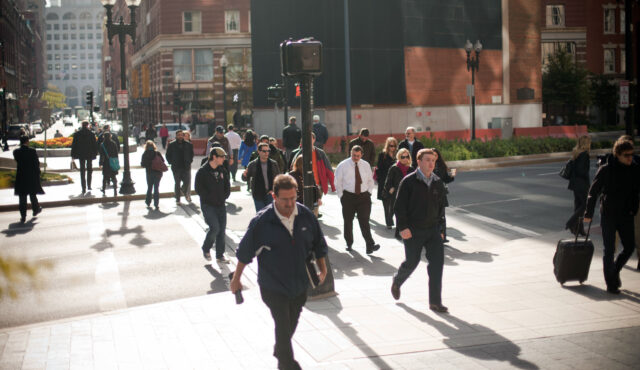On Friday, December 4, President Obama signed into law the “Fixing America’s Surface Transportation Act” or FAST Act.
The bill provides five years of funding—starting in the current Federal fiscal year, FY2016—for Federal highways and transit programs at slightly increased funding levels and uses essentially the same funding programs as we have today (including the core funding programs for bicycling and pedestrian projects). Over the five-year life of the bill, highway funding increases by 15% and transit funding by 18%.
The bill is 1,300 pages long, totals $305 billion in spending, and addresses a wide range of issues including highway, transit, highway safety, motor carrier safety, rail and other related programs. The notable changes or new elements to the bill include new freight programs, and a significant streamlining of project approvals and environmental reviews.
What Does FAST Mean for Bike/Ped Funding?
Since 1991, the biggest sources of funding for bicycle and pedestrian projects have been the Transportation Enhancements (TE) program, Surface Transportation Program (STP), Congestion Mitigation and Air Quality (CMAQ) program, Recreational Trails Program (RTP) and the Safe Routes to School (SRTS) program. In 2012, Moving Ahead for Progress in the 21st Century (MAP-21) combined the TE, SRTS and RTP programs into one Transportation Alternatives Program (TAP).
The biggest change to these programs in the FAST Act is that the STP is renamed the Surface Transportation Block Grant (STBG) program and the TAP becomes a set-aside program of this block grant. Walking and bicycling projects remain an eligible activity for the larger STBG as well as CMAQ and the Highway Safety Improvement Program (HSIP).
So, what used to be the Transportation Alternatives Program (which used to be the Transportation Enhancements program, and the Safe Routes to School and Recreational Trails program) is now the “Surface Transportation Block Grant Set-aside Program.” Just as with the TAP, funding in the STBG Set-aside Program is available for more than just bike and pedestrian projects.
TAP funding was set at 2% of all the core highway programs and yielded approximately $820 million in FY 2015. Funding levels in the new STBGSP are set at $835 million for FY2016 and FY2017, rising to $850 million in FY2018-FY2020. Within that, funding for the Recreational Trails Program is preserved at the 2009 level and is effectively a set-aside of the STBGSP
Other relevant details of the STBGSP include:
- The formula for distributing the funds at the state/local level remain the same
- Larger MPOs that get these funds directly (rather than through the state) can spend up to 50% of their funds for general STBG (or STP) projects, but have to use the same application process
- NGOs are eligible to receive these funds
- Agencies administering these funds have to produce an annual report showing the total amounts requested, for what types of project, and the number of projects selected.
The Surface Transportation Program (now the STBG program) and the Congestion Mitigation/Air Quality program remain largely the same—bike and pedestrian projects are still broadly eligible.
The Highway Safety Improvement Program (HSIP), which accounted for just 3.6% of nonmotorized funding in FY2015, is made slightly less accessible by a prohibition of funding for non-construction activities (i.e. promotion, education or enforcement).
This latter change is slightly made up for in a new non-motorized safety funding program to be administered by the National Highway Traffic Safety Administration (under their Section 405 National Priority Safety Programs). Approximately $14m annually (5% of the $280 million allocated to the program overall) will be awarded to States to decrease bike and pedestrian crashes with motor vehicles. States where bike and pedestrian fatals exceed 15% of their overall traffic fatalities will be eligible for grants that can be used for:
- Training law enforcement officials on bike/ped related traffic laws
- Enforcement campaigns related to bike/ped safety
- Education and awareness programs related to relevant bike/ped traffic laws
Based on 2013 data from the National Highway Traffic Safety Administration, this affects 20 States, the District of Columbia and Puerto Rico. (South Carolina had exactly 15%; the legislation confers eligibility on states “in excess of 15%”)
(States with greater than 15% were: AZ, CA, DE, FL, GA, HI, IL, LA, MD, MA, MI, NV, NJ, NM, NY, NC, OR, RI, TX, UT, DC and PR)
Transit funding remains generally eligible to be spent on bike and pedestrian projects—two minor incentives to use transit funds for bicycling projects disappear: the transit enhancements program (previously rarely achieved 1% set-aside) and the more favorable 90% Federal match (versus the normal 80%).
Complete Streets policy language
The FAST Act has minor changes to policy and planning language that strengthen the expectation that states and localities should have a ‘complete streets” approach to roadway design.
- There is a small change to language that now requires State DOTs “shall consider” the access of all users to non-Interstate NHS roads.
- USDOT is asked to “encourage” States and MPOs to adopt design standards that ensure the safe and accessible accommodation of all users (i.e. Complete Streets).
- The NACTO Urban Streets Design Guide is added to the list of appropriate design manuals to use for Federally-funded projects.
TIFIA and TIGER
In 1998, Congress created the Transportation Infrastructure Finance and Innovation Act (TIFIA) to provide credit assistance to large-scale surface transportation projects. The threshold for project eligibility was set at a minimum cost of $50 million ($25 million for rural infrastructure projects). The FAST Act lowers this threshold to $10 million for projects involving local governments, and allows the bundling of projects to meet this lower threshold. This should make it easier for active transportation projects to use these credit and innovative financing mechanisms. The Transportation Investment Generating Economic Recovery (TIGER) grant program was created in 2009 and has included many bicycling and walking projects and programs in the seven rounds of funding awarded since then. While the program is administered by the US Department of Transportation, funding is provided by an annual appropriation rather than a periodic transportation bill such as the FAST Act.
No Mention Equals No Change
The FAST Act, as with all previous transportation bills, amends Title 23 of the US Code. Therefore, if the FAST Act doesn’t mention a particular program or policy, that program or policy remains in place. For example, it was ISTEA in 1991 that amended Title 23 to require States to have a bicycle and pedestrian coordinator. Subsequent legislation, including the FAST Act, has made no mention of this provision, therefore it remains in place.
When Does FAST Take Effect?
The legislation takes effect immediately and authorizes funding for programs in this fiscal year (FY2016). In most cases, the transition to the provisions of the FAST Act will be minor—however, new programs such as the nonmotorized safety program may take a little time to establish. Funds unspent from prior years remain available for three years, even if the program itself has disappeared. For example, most states had unspent balances in their Transportation Enhancements and Safe Routes to Schools programs when the programs were effectively ended by MAP-21; however, FHWA reports that $186 million of TE and $83 million of Safe Routes funding was obligated by states in FY2015.
Conclusion
Perhaps the most significant thing about the FAST Act is that it provides five years of certainty for State and local agencies that depend on this funding for critical transportation infrastructure projects. Effectively, very little has changed in the funding programs and structure compared to MAP-21 and prior years—bicycling and walking projects remain broadly eligible in all the major funding categories and the funding for more targeted programs—now known as the Surface Transportation Block Grant Set-aside Program—remains at a similar level.


